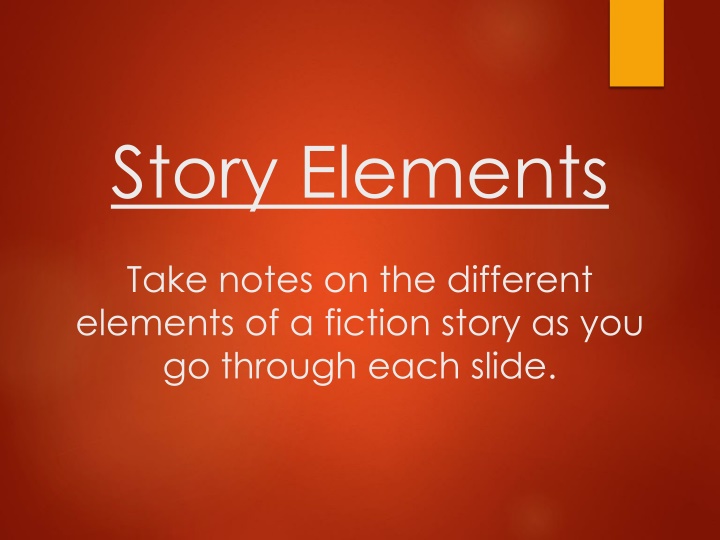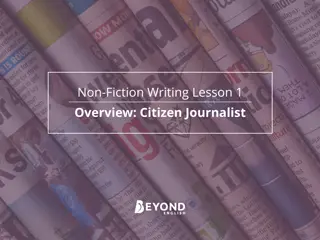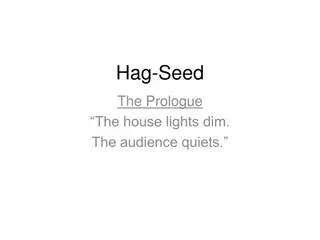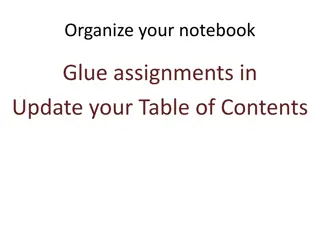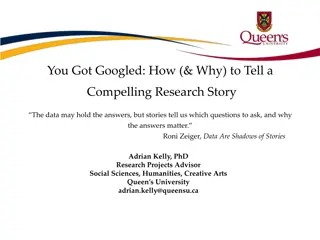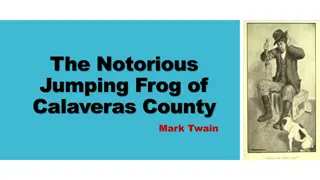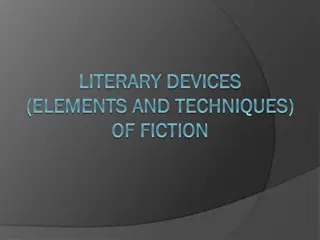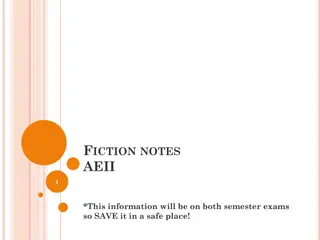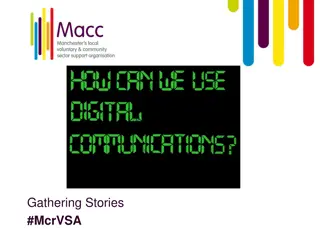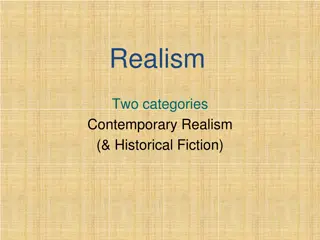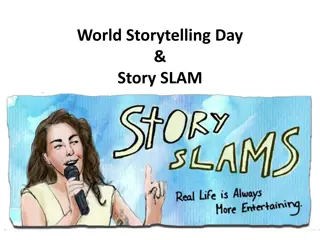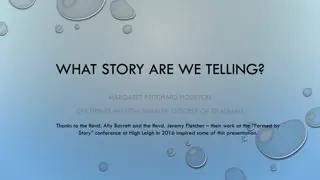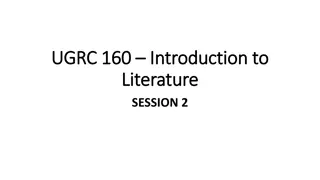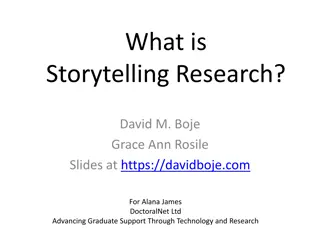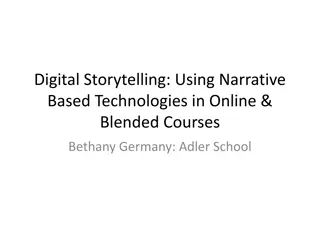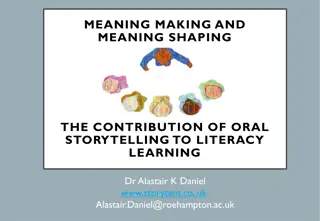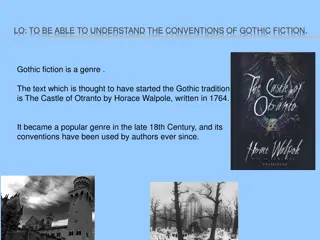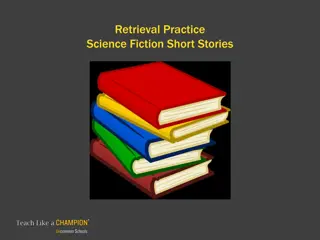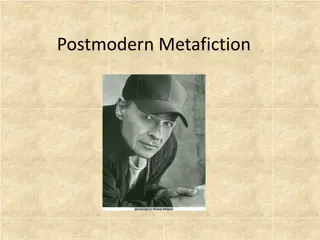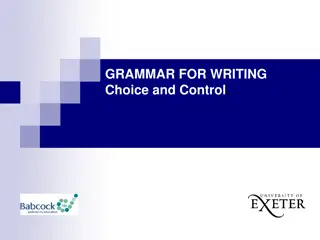Essential Elements of Fiction Storytelling
Dive into the key components that make up a compelling fiction story, including plot development, setting, mood creation, character conflicts, and the use of imagery and dialogue to enhance the reader's experience. Explore these foundational elements to enhance your storytelling skills.
Download Presentation

Please find below an Image/Link to download the presentation.
The content on the website is provided AS IS for your information and personal use only. It may not be sold, licensed, or shared on other websites without obtaining consent from the author.If you encounter any issues during the download, it is possible that the publisher has removed the file from their server.
You are allowed to download the files provided on this website for personal or commercial use, subject to the condition that they are used lawfully. All files are the property of their respective owners.
The content on the website is provided AS IS for your information and personal use only. It may not be sold, licensed, or shared on other websites without obtaining consent from the author.
E N D
Presentation Transcript
Story Elements Take notes on the different elements of a fiction story as you go through each slide.
Literary Devices of Fiction Setting Plot Character Conflict Point of View Theme Mood Dialogue Rhetorical Devices Flashback Foreshadowing Figurative Language Sensory Details Allusion
Plot (element) Plot is the basic sequence of events in a story. In conventional stories, plot has five parts: exposition, rising action, climax, falling action, and resolution.
Elements of Plot Exposition-the setting (time, place, season), introduction of characters, setting the scene Rising Action-A series of events leading up to the climax, usually full of hooks, predictions can be made and foreshadowing and suspense may be present Climax-The most exciting part of the plot Falling Action-Denouement, A series of events leading to the resolution and closure Resolution-Tying up all the loose ends of the literature (And they lived happily-ever-after.)
Setting (element) The setting of a story is the time and place in which it occurs. Elements of setting may include the physical, psychological, cultural, or historical background against which the story takes place.
Mood (element) The mood of a story is the atmosphere or feeling created by the writer and expressed through setting. Moody Faces
Conflict (element) In literature, conflict is the opposition of persons or forces that brings about dramatic action central to the plot of a story.
Imagery and Dialogue Imagery Dialogue The lines spoken between character in fiction or a play. The use of language to create mental images and sensory impressions. Imagery can be used for emotional effect and to intensify the impact on the reader.
Sensory Details (techniques) Sensory details are details in writing that describe what is seen, heard, smelled, tasted, or touched. Writers often use sensory details to enhance the mood and theme in writing.
Point of View-Narrator (element) The narrator is the teller of a story. Reliable narrator the reader accepts the statements of fact and judgment without serious question Unreliable narrator the reader questions or seeks to qualify the statements of fact and judgment.
Point of View The point of view is the perspective from which the events in the story are told. The author may choose to use any of the following: Omniscient/third-person omniscient Omniscient/third-person limited Objective First person/subjective Limited
Point of View Omniscient/third-person omniscient The narrator tells the story in third person from an all-knowing perspective. The knowledge is not limited by any one character s view or behavior, as the narrator knows everything about all characters. Signal pronouns he, she, they
Point of View Omniscient/third-person limited The narrator restricts his knowledge to one character s view or behavior. Signal pronouns he, she, they Objective The narrator reveals only the actions and words without the benefit of the inner thoughts and feelings. Signal pronouns he, she, they
Point of View First person/subjective The narrator restricts the perspective to that of only one character to tell the story. Signal pronouns I, we, us Limited A narrative mode in which the story is told through the point of view of a single character and is limited to what he or she sees, hears, feels, or is told. Signal pronouns I, we, us
Theme (element) The theme is the central or universal idea of a piece of fiction; it is a perception about life and the human condition. An implicit theme refers to the author s ability to construct a piece in such a way that through inference the reader understands the theme.
Theme The theme is also the main idea of a nonfiction essay. An explicit theme refers to when the author overtly states the theme somewhere in the work.
Theme A universal theme transcends social and cultural boundaries and speaks to a common human experience. The human condition encompasses all of the experience of being human. The ongoing way in which humans react to or cope with these events is the human condition.
Types of Characters (element) Dynamic character a character which changes during the course of a story or novel Static character a character who remains primarily the same during the course of a story or novel
Types of Characters Round character a well developed character who demonstrates varied and sometimes contradictory traits Flat character a two-dimensional and relatively uncomplicated character who does not change throughout a story or novel Stock Character a special kind of flat character who is instantly recognizable (stereotypical)
Types of Characters Protagonist the story s main character Antagonist a character in opposition of the protagonist Character Foil a secondary character who contrasts with the protagonist in order to highlight aspects of the main character s personality
Types of Conflict Character versus Character a conflict between one character and another Character versus Nature a conflict between a character and a force of nature Character versus Society a conflict between a character and the values, beliefs, and/or customs of a larger group Character versus Self an internal psychological conflict within a character
Character Development Internal Character Development External Character Development Actions Feelings Relationships Thoughts Dialogues Emotions
Character Motivation Character Motivation the reasons, justifications, and explanations for the action of a character Motivation results from a combination of the character s moral nature with the circumstances in which the character is placed. Motivation helps to determine what the character does, says, and feels or fails to feel.
Characterization the way an author reveals the special qualities and personalities of a character in a story, making the character believable.
Analyzing Character Traits We try to figure out what a character in a book is like by paying attention to the clues the author gives us. This is called making inferences. Example: What can you infer? No, Honey, I don t want you to spend a lot of money on my birthday present. Just having you for a husband is the only gift I need. In fact, I ll just drive my old rusty bucket of bolts down to the mall and buy myself a little present. And if the poor old car doesn't break down, I ll be back soon.
Types There are two types of characterization: Direct Indirect.
Direct Characterization Direct characterization is when the author TELLS the audience what the personality of the character is. Example: The patient boy and quiet girl were both at the game.
Indirect Characterization Indirect characterization is when the author SHOWS things that reveal the personality of the character. There are FIVE different methods of indirect characterization: speech, thoughts, effect on other characters, actions, and looks.
Indirect Characterizationwriter shows you what character is like by revealing: S- Speech T- Thoughts E- Effect on Others A- Actions L- Looks
The Difference The difference between direct characterization and indirect characterization is TELLING v. SHOWING! Indirect characterizations are like clues about the characters. There is no mystery with direct characterization because the author gives us the information we need to know!
Speech We often get to know characters because of what they say to each other. Anita threw her arms around Tony and gave him a big hug. Thank you so much for being there for me, she said. I don t think I could have faced my parents without you. thoughtful compassionate appreciative
ThoughtsWhen an author lets us get inside the mind of a character, we can often learn a great deal about him or her. Butch looked around the neighborhood. This would be a safe place to play catch with Bobby, he thought. Why doesn t Bobby throw the ball? He must be in a bad mood or something. loyal concerned playful
Effect On Others sometimes other characters will tell us something useful about the character we re reading about. You wouldn t believe what Lisa did yesterday, Sara said to her sister. When we went into the bridal shop, she pushed all the women aside and demanded that the sales lady help us immediately. It was really something! Demanding pushy assertive
ActionsMuch of what we learn about characters is revealed to us through what they do. Denise picked up the slimy bull frog. She could hardly stand to hold it even for a moment. She held it out at arm s length from her body and quickly carried it to her brother. squeamish sensitive nervous
Looks Can infer a lot about characters from the clothes they wear, their facial features, their body language, and their mannerisms. Tex was the head rancher on the farm. When he rounds up the horses, he can be easily spotted with his beige hat and vest. Tex s smile is a mile wild, even with his bushy mustache. jovial proud dedicated
Closing Complete a Vocabulary Study to your Vocabulary Study Unit 1 Sheet for each of the following terms: Direct Characterization Indirect Characterization Static Character Dynamic Character Round Character Flat Character
